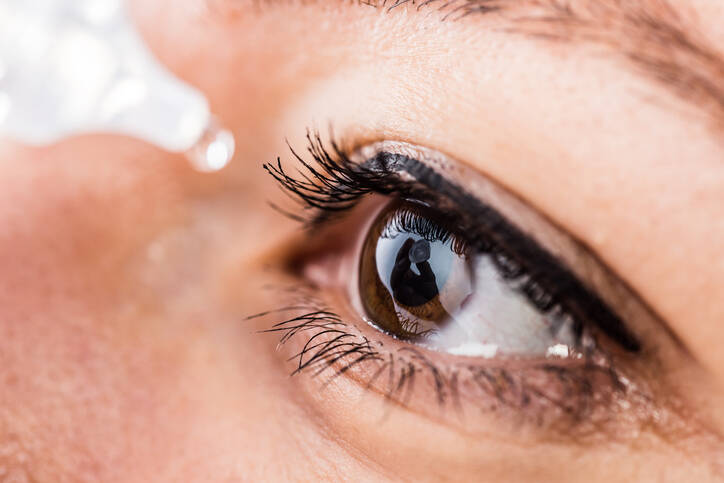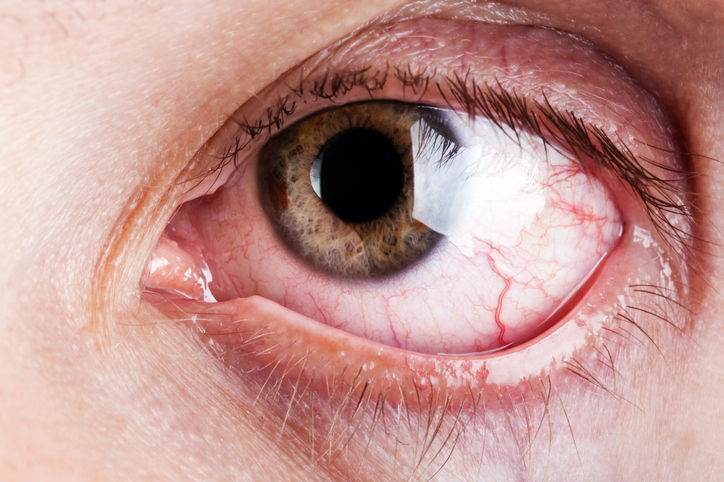- Critser, Brice. "Lissamine green staining in keratoconjunctivitis sicca". Eye Rounds. The University of Iowa. Archived from the original on 7 August 2016. Retrieved 29 July 2016.
- "Facts About Dry Eye". NEI. February 2013. Archived from the original on 28 July 2016. Retrieved 29 July 2016.
- Kanellopoulos, AJ; Asimellis, G (2016). "In pursuit of objective dry eye screening clinical techniques". Eye and Vision. London. 3: 1. doi:10.1186/s40662-015-0032-4. PMC 4716631. PMID 26783543.
- Michelle Meadows (May–June 2005). "Dealing with Dry Eye". FDA Consumer Magazine. U.S. Food and Drug Administration. Archived from the original on February 23, 2008.
- Messmer, EM (30 January 2015). "The pathophysiology, diagnosis, and treatment of dry eye disease". Deutsches Ärzteblatt International. 112 (5): 71–81, quiz 82. doi:10.3238/arztebl.2015.0071. PMC 4335585. PMID 25686388.
- Tavares Fde, P; Fernandes, RS; Bernardes, TF; Bonfioli, AA; Soares, EJ (May 2010). "Dry eye disease". Seminars in Ophthalmology. 25 (3): 84–93. doi:10.3109/08820538.2010.488568. PMID 20590418. S2CID 207474207.
- Ding, J; Sullivan, DA (July 2012). "Aging and dry eye disease". Experimental Gerontology. 47 (7): 483–90. doi:10.1016/j.exger.2012.03.020. PMC 3368077. PMID 22569356.
- Liu, NN; Liu, L; Li, J; Sun, YZ (2014). "Prevalence of and risk factors for dry eye symptom in mainland china: a systematic review and meta-analysis". Journal of Ophthalmology. 2014: 748654. doi:10.1155/2014/748654. PMC 4216702. PMID 25386359.
- Firestein, Gary S. (2013). Kelley's textbook of rheumatology (9th ed.). Philadelphia: Elsevier/Saunders. p. 1179. ISBN 978-1437717389. Archived from the original on 2017-09-08.
- "Keratoconjunctivitis Sicca". The Merck Manual, Home Edition. Merck & Co. 2003-02-01. Archived from the original on 2006-11-12. Retrieved 2006-11-12.
- "Keratoconjunctivitis, Sicca". eMedicine. WebMD, Inc. January 27, 2010. Archived from the original on March 7, 2010. Retrieved September 3, 2010.
- "Dry eyes". MedlinePlus Medical Encyclopedia. U.S. National Library of Medicine. 2006-10-04. Archived from the original on 2006-12-06. Retrieved 2006-11-16.
- "Dry eyes". Mayo Clinic. Mayo Foundation for Medical Education and Research. 2006-06-14. Archived from the original on 2007-03-24. Retrieved 2006-11-17.
- Guo, Y; Peng, R; Feng, K; Hong, J (2016). "Diagnostic performance of McMonnies Questionnaire as a screening survey for dry eye: A multicenter analysis". Journal of Ophthalmology. 2016: 6210853. doi:10.1155/2016/6210853. PMC 4884592. PMID 27293876.
- Sendecka M, Baryluk A, Polz-Dacewicz M (2004). "Częstość występowania zespołu suchego oka" [Prevalence and risk factors of dry eye syndrome]. Przegla̧d Epidemiologiczny (in Polish). 58 (1): 227–33
Dry eye syndrome: burning and tired eyes? Causes and symptoms

Photo source: Getty images
Most common symptoms
- Headache
- Eye Pain
- Sensitivity to light
- Bulk on the cap
- Swollen eyelid
- Eye irritation
- Cutting the eye
- Itchy eye
- Pressure in the eye
- Fatigue
- Redness of the conjunctivae
- Redness of the eyelid
- Blurred vision
- Deterioration of vision
- Reduced tearing
- Increased watery eye
Show more symptoms ᐯ
How to treat dry eye syndrome: are dry eye drops, artificial tears enough?
Show moreDry eye syndrome is treated by
Other names
Dry eye, keratoconjunctivitis sicca, dry eye disease (DED), keratitis sicca













